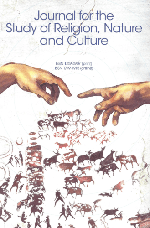Meet ISSRNC Board Member Dan Smyer Yü
We’re pleased to share this recent interview with ISSRNC board members Dan Smyer Yü. The following interview was conducted by ISSRNC President-Elect Evan Berry, and was edited for clarity.
ISSRNC: You’ve been on the ISSRNC Board for about a year now. Tell us a little about yourself and how you came to be interested in the intersections of religion, nature, and culture?
Dan Smyer Yü: I’m very happy to have the opportunity to serve the ISSRNC and work with marvelous people I’ve known and/or collaborated with for nearly a decade like Evan Berry, Georgina Drew, Mark Peterson, and Bron Taylor. What first and foremost attract me to the ISSRNC are their inspirational works on religion, nature and culture. I was trained as a cultural anthropologist at the University of California Davis specializing in modern Sino-Tibetan Buddhist encounters and Tibetan sacred landscape studies. So, my work started out with religion, culture and politics. Nature was present in my early scholarly works, mostly found in my study of sacred landscapes and pilgrimage sites.
I think 2010-2012 were the years when I began to commit myself fully to the studies of religion, nature, and culture. At the time, I was working with Mary Evelyn Tucker and John Grim to co-organize a publishing workshop on religious diversity and ecological sustainability in China. I was also preparing my participation in a Himalayan sustainability conference in New York, for which Gina Drew was one of the organizers and where I also met Bron Taylor. Since then, my anthropological work has evolved into an interdisciplinary study of religion, nature and culture.
My home base is the Sacramento Valley. I’ve worked in Europe and Asia. Currently I’m a Kuige Professor of Ethnology at Yunnan University in Kunming, China. With the geographical advantage of this position in the Southeast Asian Massif inclusive of Southwest China, I’ve been expanding my geographical specializations for the last six years to the highlands of Burma and
the Himalayan region. As a co-founder and co-leader of the Trans-Himalayan Environmental Humanities Thematic Working Group at the Himalayan University Consortium (HUC is a Himalaya-based higher education network with 80 university members), my current research directions focus on the anthropogenic impacts in the Himalayas, the ecological meanings of indigeneity, and human-earth affective bonds through religious and spiritual practices.

Dan Smyer Yü, Kuige Professor of Ethnology at Yunnan University, China.
ISSRNC: You are working on several new projects, including two forthcoming books that each take a “trans-Himalayan” approach. Given how important the Himalayan region is to the planetary ecosystem, what is this approach and how would you situate your work within it?
Dan Smyer Yü: Yes, one of them is published with Amsterdam University, titled Trans-Himalayan Borderlands: Livelihoods, Territorialities, Modernities. The other one was recently submitted to Routledge Environmental Humanities Series for review. The title is Trans-Himalayan Environmental Humanities: Symbiotic Indigeneity, Aqueous earth, Biotic-Abiotic Unions. Speaking of “trans-Himalayas” or “trans-Himalayan,” the prefix is meant to emphasize the transboundary nature of Himalayan environmental flows as well as human and animal transboundary migrations and interactions. Conceptually, “trans-” suggests a range of transitional actions and their outcomes in both environmental, human, and nonhuman terms, such as transferring, transporting, transmitting, transforming, and transcending. Religiously, there are multiple Himalayas, such as indigenous Himalayas, animist Himalayas, shamanic Himalayas, Hindu Himalayas, Buddhist Himalayas, Hindu-Buddhist syncretic Himalayas, and Muslim Himalayas. The everyday forms of these religious and spiritual traditions are all place-based and ecologically-niched and, therefore, integrate themselves with nature and culture. In whole, “trans-“ signifies transboundary flows and connectivity.
The Himalayas is a planetary importance. Its water source alone sustains over 2 billion populations across East Asia, South Asia, and Southeast Asia. On the global scale, like the Arctic, the Himalayas is a planetary waterscape in both solid and liquid forms. The environmental conditions of both reflect global climate change and anthropogenic impacts in most sensitive ways in the Anthropocene. Both are homes to indigenous populations who hold environmental wisdoms that can tremendously benefit the ongoing global endeavors for building a sustainable future. In the aspect of human ethnolinguistic diversity and biodiversity,
the Himalayas is much more diverse than the Arctic.
Research wise, I take an affective, ontological approach to the study of religion-nature-culture nexus in the Himalayas. The Himalayan nations and communities have been recipients of “sustainable development” oriented policies and modernization programs; however, the Himalayan environment has rather worsened in the last four decades. The language of sustainable development often appears technocratic and highly specialized, and, thus, has not been available enough for community participation in decision processes. I separate “development” from “sustainability” for the sake of conceptual clarity. When they are together, the phrase is quite slippery. Since the technical, technological, and technocratic approaches to a sustainable Himalayas have not been too successful, I’d like to explore, understand, and translate native peoples’ lived experiences of sustainable living into interdisciplinary, policy-intelligent terms.
Based on my ongoing fieldwork and conceptual work, human affective relations with the earth, plants, and animals are a critical foundation of a sustainable future. The challenge is that these relationships are intangible but felt and expressed in spiritual practices, indigenous earth-mythologies, world religions’ cosmovisions, local poetry and literature, and everyday modes of being. This is where I’m making effort to bridge religion and ecology, environmental humanities, and earth science for diversifying existing affective approaches and yielding outcomes that can be shared widely beyond the Himalayas.
Dan Smyer Yü is Kuige Professor of Ethnology, School of Ethnology and Sociology and the National Centre for Borderlands Ethnic Studies in Southwest China at Yunnan University. He received his Ph.D. in anthropology from the University of California at
Davis in 2006. Prior to his current faculty appointment, he was the Founding Director of the Center for Trans-Himalayan Studies at Yunnan Minzu University, a Senior Researcher/Research Group Leader at the Max Planck Institute for the Study of Religious
and Ethnic Diversity, a core member of the Transregional Research Network (CETREN) at University of Göttingen, and a New Millennium Scholar at Minzu University of China, Beijing. He is the author of The Spread of Tibetan Buddhism in China: Charisma,
Money, Enlightenment (Routledge 2011) and Mindscaping the Landscape of Tibet: Place, Memorability, Eco-aesthetics (De Gruyter 2015), and the co-editor of Religion and Ecological Sustainability in China (Routledge 2014) and Trans-Himalayan Borderlands:
Livelihoods, Territorialities, Modernities (Amsterdam University Press 2017). His research interests are religion and ecology, environmental humanities, trans-Himalayan studies, sacred landscapes, climate change and mass migration, modern Tibetan studies, and comparative studies of Eurasian secularisms. His externally funded projects are “Trans-Himalayan Environmental Humanities” (ICIMOD), “India-China Corridor Project” (the Swedish Research Council), “Cultural and Ecological Diversity of the
Trans-Himalayas in the Context of China’s Belt and Road Initiative” (National Social Sciences Foundation of China), and “Sustainable Lives in Scarred Landscapes: Heritage, Environment, and Violence in the China-Myanmar Jade Trade” (The British Academy Sustainable Development Program).












